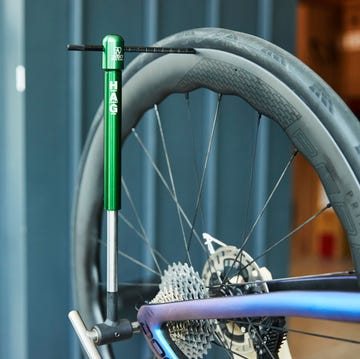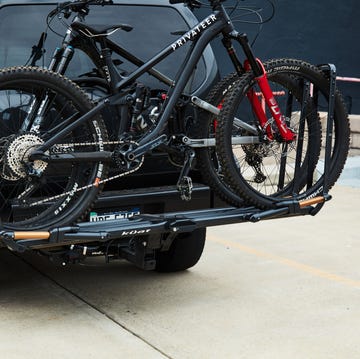The Takeaway: All the features and performance of SRAM’s XX1 AXS drivetrain but a bit heavier and a whole lot cheaper.
- The $370 GX AXS rear derailleur has same clutch, motor, electronics as the $700 XX1 AXS rear derailleur.
- Can be mixed with all other Eagle components, and can be compatible with other parts in SRAM's AXS ecosystem
Price: $520 (rear derailleur, shifter, battery)
Weight: 532 grams (rear derailleur, shifter, battery)
SRAM GX Eagle AXS—What’s New
Not much! All the same features and tech found in SRAM’s XX1 and X01 AXS rear derailleur and shifter are in the GX Eagle AXS derailleur and shifter.
All three rear derailleurs share the same battery, clutch, motor, electronics, and features: what you’re paying for are materials and weight. The GX Eagle derailleur is 439 grams on my scale, about 90 grams heavier than XX1 AXS and about 75 grams heavier than X01 AXS.
The rest of the GX Eagle AXS group—crank, cassette, chain—is shared with the refreshed GX Eagle (mechanical) group launched in June. It’s also, like the other Eagle AXS rear derailleurs, computable with SRAM’s 10-52 cassettes.
SRAM did use this opportunity to roll out a clip-on battery protector $20 which is compatible with other Eagle AXS rear derailleurs.
On my scale, the GX Eagle AXS shifter came in seven grams lighter than the XX1/X01 AXS shifter, but the GX is $50 cheaper. As far as I can tell, the GX shifter is identical to the XX1/X01 shifter: The GX shifter has the same features as the XX1/X01 shifter, including the interchangeable shifter paddle. Why is it $50 cheaper? I asked SRAM’s PR man Chris Mandell, and he responded, “The differences for the GX shifter are the finish and that it uses the original paddle shape. The X01 and XX1 will now ship with the new shape.”
And that’s it, really. GX Eagle AXS is simply XX1 Eagle AXS rendered in less expensive (heavier) materials. Features and shifting performance are identical. So, the real story here is SRAM brought the features and tech of the $700 XX1 AXS rear derailleur to a derailleur that’s nearly half the cost of the XX1. Add in the shifter, and GX Eagle AXS is 42 percent cheaper than XX1 AXS and 26 percent cheaper than X01 AXS.
SRAM GX Eagle AXS—Prices and Weights
GX Eagle AXS is the heaviest and cheapest of the three Eagle AXS groups, as my table makes clear. If I were assembling the best weight for the dollar group, I’d go with GX shifter, derailleur, and chain and upgrade to the X01 crank and cassette. That’d work out to an approximately 1600g group with a price of $1,310.
For a mechanical comparison: The X01 Eagle 520 rear derailleur ($199), X01 Eagle shifter ($89), and associated cable and housing I pulled off the bike to install my GX Eagle AXS weighed 462g—The GX Eagle AXS shifter, derailleur, and battery weigh 523g.
SRAM GX Eagle AXS—Ride Impressions
As noted above, the GX Eagle AXS rear derailleur has the same clutch, motor, and electronics as XX1 AXS and X01 AXS. And other than cosmetics, the GX AXS shifter is identical to the $200 XX1/X01 AXS shifter, though the GX shifter is $50 cheaper and comes in seven grams lighter on my scale. The weight difference seems mostly due to the GX’s lighter paddle
It is no big surprise then that you could copy and paste my impressions of XX1/X01 Eagle AXS shifting and apply it to GX Eagle AXS. That’s just what I’ll do.
“Eagle AXS is SRAM’s best-shifting mountain bike drivetrain. Shifts are precise and smooth and very quick. It shifts more efficiently and is more consistent than mechanical-shift Eagle and shifts better in demanding situations—rough terrain, high torque—as well.”
The shifter ergonomics are good: The paddle is large enough without being obtrusive. Travel and spring tension are well balanced; I could ride up a technical climb with my thumb resting on the paddle without triggering an unwanted shift. There’s a reassuring “click” with every shift as well.”
I think Shimano’s (mechanical) 12-speed mountain bike drivetrain shifts are smoother and seem more refined than SRAM’s stuff (including AXS), and Shimano’s upshifts better under high loads, which is nice as you’re firing off shifts while picking up speed. But while real, the differences are minor.
AXS is excellent stuff and has both the advantages of electronic shifting—no cable and housing wear out, less throw required to shift, customizable shifting—and wireless—no housing to install and maintain, no housing to rattle or catch on sicks, easier to pack a bike for travel. And credit to SRAM for, so far, pantsing Shimano in the tech department. SRAM has three 12-speed wireless electronic mountain bike drivetrains: Shimano’s 12-speed mountain groups are, so far, only offered with mechanical shifting.
So, if you’ve wanted to upgrade to SRAM’s AXS wireless shifting but found the X01/XX1 AXS stuff too expensive, GX AXS should be a lot more palatable. It’s XX1 AXS-level shifting and features for 42-percent less.

A gear editor for his entire career, Matt’s journey to becoming a leading cycling tech journalist started in 1995, and he’s been at it ever since; likely riding more cycling equipment than anyone on the planet along the way. Previous to his time with Bicycling, Matt worked in bike shops as a service manager, mechanic, and sales person. Based in Durango, Colorado, he enjoys riding and testing any and all kinds of bikes, so you’re just as likely to see him on a road bike dressed in Lycra at a Tuesday night worlds ride as you are to find him dressed in a full face helmet and pads riding a bike park on an enduro bike. He doesn’t race often, but he’s game for anything; having entered road races, criteriums, trials competitions, dual slalom, downhill races, enduros, stage races, short track, time trials, and gran fondos. Next up on his to-do list: a multi day bikepacking trip, and an e-bike race.



















